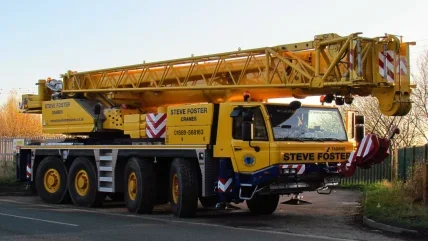
Any calculation of the dead weight of a mobile crane includes the boom, the machinery, the chassis and the counterweight. For an offshore pedestal crane, however, the dead weight also includes the weight of the installation that the crane is fixed to. This could be a vessel or an oil platform.
When a mobile crane is overloaded, the centre of gravity moves from the area of stability towards the load that is being lifted, thus raising the risk of the crane overturning. Offshore pedestal cranes are different; their dead weight is so large that there is a greater reliance on the strength of the components. Given the same overload, it is unlikely that the crane will overturn. The question is, however, what impact do the stresses created by an overload situation have on this type of crane?
A severe overload could pull the crane off the pedestal in extreme cases. This is a very rare occurrence because most cranes are now fitted with gross overload protection devices. Lesser overloads can stress the boom strut welds, and over a period of time the crane boom might collapse. It would be interesting to note how many boom failures have occurred due to stressed welds. Cranes offshore are also subjected to environmental factors that can be hazardous, and therefore require good crane management and competent operation to ensure a safe lifting operation.
Dynamic loading is the effect on the crane when it is shock loaded. This sometimes occurs when cargo is transferred from a supply vessel deck to an installation. The average wave height when unloading vessels in the North Sea is around 3m. If the crane operator gets it wrong, and hoists the cargo as the vessel is dropping into the trough of a wave, the resulting shock load will create a dynamic effect that can increase the load on the crane by up to three times the actual weight being lifted.
When the lifting operation is between two vessels such as a drilling semi and a supply vessel the effects of pitch and roll are critical as the dynamic factors are further increased. This effect will continue for a short time, depending on the boom length and angle.
Unless the risk of dynamic loading is addressed, this dynamic loading will result in a series of overloads.
To alleviate dynamic loading the operator should be hoisting the cargo from the deck just as the supply vessel is rising or is at the top of the wave. More importantly, he should ensure correct selection and setting of the appropriate sea state on the rated capacity indicator (RCI). This should be done throughout the lifting operation, and the wave height should be updated by an appointed person. These sea state duties will de-rate the crane’s safe working limit (SWL), depending on the wave height. For example, when the duties for a National OS 435 main hoist at high speed are selected for a static lift (sea state 0) they have a SWL of 23t up to a 25m radius. When the duties are set for a dynamic lift at a sea state of seven, the SWL is 9t for the same radius. This reduction in capacity is an allowance for the dynamic effect; an increase between actual load moment and peak load moment.
There are still some offshore cranes on installations operating dynamic lifts from supply vessels that have an RCI with duties only suitable for static lifting. In such cases, the operator must use a duty chart to determine the safe working load of the crane when lifting dynamically, and as the crane duties on the RCI are for static lifting there is no audible or visual warning of an overload. There are a number of references to dynamic lifting in the UK’s Lifting Operations & Lifting Equipment Regulations (LOLER) 1998. One of these, Regulation 4, clearly states: ‘Where there is a significant risk of overturning and/or overloading arising from the use of the equipment, it should be provided where appropriate with equipment or devices such as rated capacity indicators and rated capacity limiters. Such devices provide audible and/or visual warning when the safe lifting limits are being approached.’
Another reference to this type of lifting can be found in the Approved Code of Practice for Safe use of cranes British Standard S7121-11: 1998. Here, Part 5.2 clearly states: ‘The rated capacity indicator and limiter should be maintained in working order. The crane operator should:
a) Ensure correct selection of duties for inboard lifting operations on the installation, and if applicable, the correct duties for lifting over the sea from supply vessels allied to the prevailing sea state.
b) Ensure correct selection and setting of the sea status throughout the lifting operation, from continuous updates provided by the appointed person.’
If the operator relies only on the RCI with static duties to indicate the SWL of the crane during dynamic lifting, then the crane is at risk of severe overloading, and components are likely to fail as a result.






